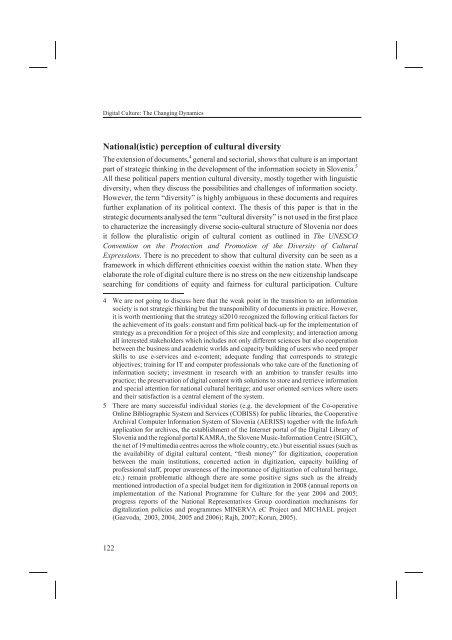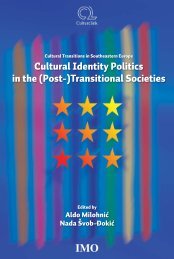D:\Documents and Settings\Ana\My Documents\Biserka-knjiga ...
D:\Documents and Settings\Ana\My Documents\Biserka-knjiga ...
D:\Documents and Settings\Ana\My Documents\Biserka-knjiga ...
Create successful ePaper yourself
Turn your PDF publications into a flip-book with our unique Google optimized e-Paper software.
Digital Culture: The Changing Dynamics<br />
National(istic) perception of cultural diversity<br />
The extension of documents, 4 general <strong>and</strong> sectorial, shows that culture is an important<br />
part of strategic thinking in the development of the information society in Slovenia. 5<br />
All these political papers mention cultural diversity, mostly together with linguistic<br />
diversity, when they discuss the possibilities <strong>and</strong> challenges of information society.<br />
However, the term “diversity” is highly ambiguous in these documents <strong>and</strong> requires<br />
further explanation of its political context. The thesis of this paper is that in the<br />
strategic documents analysed the term “cultural diversity” is not used in the first place<br />
to characterize the increasingly diverse socio-cultural structure of Slovenia nor does<br />
it follow the pluralistic origin of cultural content as outlined in The UNESCO<br />
Convention on the Protection <strong>and</strong> Promotion of the Diversity of Cultural<br />
Expressions. There is no precedent to show that cultural diversity can be seen as a<br />
framework in which different ethnicities coexist within the nation state. When they<br />
elaborate the role of digital culture there is no stress on the new citizenship l<strong>and</strong>scape<br />
searching for conditions of equity <strong>and</strong> fairness for cultural participation. Culture<br />
4 We are not going to discuss here that the weak point in the transition to an information<br />
society is not strategic thinking but the transponibility of documents in practice. However,<br />
it is worth mentioning that the strategy si2010 recognized the following critical factors for<br />
the achievement of its goals: constant <strong>and</strong> firm political back-up for the implementation of<br />
strategy as a precondition for a project of this size <strong>and</strong> complexity; <strong>and</strong> interaction among<br />
all interested stakeholders which includes not only different sciences but also cooperation<br />
between the business <strong>and</strong> academic worlds <strong>and</strong> capacity building of users who need proper<br />
skills to use e-services <strong>and</strong> e-content; adequate funding that corresponds to strategic<br />
objectives; training for IT <strong>and</strong> computer professionals who take care of the functioning of<br />
information society; investment in research with an ambition to transfer results into<br />
practice; the preservation of digital content with solutions to store <strong>and</strong> retrieve information<br />
<strong>and</strong> special attention for national cultural heritage; <strong>and</strong> user oriented services where users<br />
<strong>and</strong> their satisfaction is a central element of the system.<br />
5 There are many successful individual stories (e.g. the development of the Co-operative<br />
Online Bibliographic System <strong>and</strong> Services (COBISS) for public libraries, the Cooperative<br />
Archival Computer Information System of Slovenia (AERISS) together with the InfoArh<br />
application for archives, the establishment of the Internet portal of the Digital Library of<br />
Slovenia <strong>and</strong> the regional portal KAMRA, the Slovene Music-Information Centre (SIGIC),<br />
the net of 19 multimedia centres across the whole country, etc.) but essential issues (such as<br />
the availability of digital cultural content, “fresh money” for digitization, cooperation<br />
between the main institutions, concerted action in digitization, capacity building of<br />
professional staff, proper awareness of the importance of digitization of cultural heritage,<br />
etc.) remain problematic although there are some positive signs such as the already<br />
mentioned introduction of a special budget item for digitization in 2008 (annual reports on<br />
implementation of the National Programme for Culture for the year 2004 <strong>and</strong> 2005;<br />
progress reports of the National Representatives Group coordination mechanisms for<br />
digitalization policies <strong>and</strong> programmes MINERVA eC Project <strong>and</strong> MICHAEL project<br />
(Gazvoda, 2003, 2004, 2005 <strong>and</strong> 2006); Rajh, 2007; Korun, 2005).<br />
122



